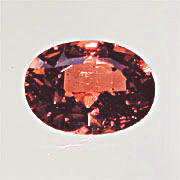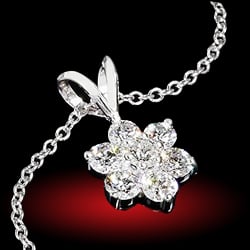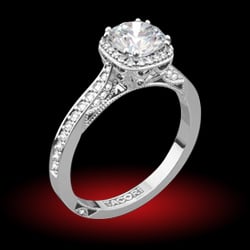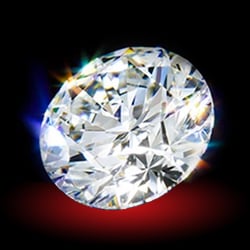Please help. I recently purchased, at auction, five Malaya garnets sizes 2.09, 2.18, 2.77, 5.46 and 7.32 carats. It was an auction of “abandoned” contents of safety deposit boxes of various banks conducted by the State of California. These stones were listed as red garnets. In fact, they all came with certificates identifying them as lightly flawed to near flawless, with color quality of select to premium, natural garnets identified as Malaya, dated 1980 to 1981. My question is that although I’ve seen many Spessartine garnets selling for around $250 to $300 a carat, I can’t find any true Malayas out there to get an idea of what they may be worth. I must add that the most beautiful Spessartine I’ve seen does not match the beauty of the 5.46 ct Malaya in this lot. The fire in this stone is amazing. I’ve seen Malaia garnets on line go for about $90 to $135/ct. The color does not compare, but they are just pictures. I paid $300 for the lot. How did I do? Any opinions? Urban prospector, Teresa.
You are using an out of date browser. It may not display this or other websites correctly.
You should upgrade or use an alternative browser.
You should upgrade or use an alternative browser.
Help with Spessartine vs. Malaya Garnet
- Thread starter Teresa
- Start date
- Status
- Not open for further replies. Please create a new topic or request for this thread to be opened.
- Joined
- Aug 29, 2003
- Messages
- 15,808
You might find the comments and examples of Malaya garnet on THIS site inetersting.
 ... given the interest of the shop's owner to promote unusual garnets.
... given the interest of the shop's owner to promote unusual garnets.
However, it is not uncommon that these less usual types of garnet get missidentified, and the bright orange that you describe sounds like hessonite to me. Not that this makes a huge difference of value - color does allot of difference (with clarity helping). Five carat "mandarin orange" & eye clean sounds like a winning combination to me, by all means.

However, it is not uncommon that these less usual types of garnet get missidentified, and the bright orange that you describe sounds like hessonite to me. Not that this makes a huge difference of value - color does allot of difference (with clarity helping). Five carat "mandarin orange" & eye clean sounds like a winning combination to me, by all means.
- Joined
- Feb 17, 2004
- Messages
- 1,104
I spent a long time writing a detailed answer for you and when I previewed it PriceScope software automatically truncated it. I'm disgusted! If you want me to send you the complete information contact me privately.
Meanwhile, I suggest you contact Richard Hughes at Pala International, who helped John D. Rouse with the technical aspects of his well-known book "Garnet." It features a huge orange malaia as its cover art. Garnets are extremely complicated and intermediate-species types like malaia (pyrope and spessartite) are especially so.
If the image I uploaded shows up, it's one of the malaias Pala is currently offering for sale. It may help you with your question about color. Others are shown at the Pala site. Since malaia's an intermediate and can have different proportions of pyrope and spessartite, color can range from slightly pinkish-orange to slightly orangeish-red.
Richard M.

Meanwhile, I suggest you contact Richard Hughes at Pala International, who helped John D. Rouse with the technical aspects of his well-known book "Garnet." It features a huge orange malaia as its cover art. Garnets are extremely complicated and intermediate-species types like malaia (pyrope and spessartite) are especially so.
If the image I uploaded shows up, it's one of the malaias Pala is currently offering for sale. It may help you with your question about color. Others are shown at the Pala site. Since malaia's an intermediate and can have different proportions of pyrope and spessartite, color can range from slightly pinkish-orange to slightly orangeish-red.
Richard M.

katbadness
Shiny_Rock
- Joined
- Jan 29, 2004
- Messages
- 480
----------------
On 6/21/2004 12:07:03 PM Richard M. wrote:
I spent a long time writing a detailed answer for you and when I previewed it PriceScope software automatically truncated it. I'm disgusted! If you want me to send you the complete information contact me privately.
----------------
Richard,
I don't think your long message will not be truncated once posted. I believe *only* the preview function does that (it happened to me in the past, too!).
I'm very looking forward to reading your detailed answer, so I really hope you'll post it on the board (or PM me

- Joined
- Feb 17, 2004
- Messages
- 1,104
Katbadness,
Okay, truncated or not, here goes:
Teresa,
You possibly have done well depending on several complex factors. I’ve been struggling with garnet identification and valuation for several years and you find yourself in the midst of a tremendously difficult and debatable area of gemology. Here’s why:
Garnets are not a single mineral but a group. All known natural garnets are silicates that crystallize in the cubic system. (Synthetic so-called “garnets” like GGG, YAG, etc., are cubic but not silicates). Each species has identifiable chemistry based on a dominant chemical element. So pyrope, koharite, knorringite, etc. are magnesium garnets; almandine and skiagite, iron garnets; spessartite, yamatoite, calderite and blythite, managanese, etc. (There are about 20 known species of natural garnet -- called ‘end members’ -- but as many as 60 are possible...they simply haven't been discovered yet. Only five are regularly used as gems: pyrope, almandine, spessartite, grossular and andradite. Beautiful green uvarovite druses are sometimes seen but individual crystals are too small to cut into gems).
If that’s not complex enough, it becomes even more interesting. Garnet species are almost never pure because of “isomorphous replacement,” also called “miscibility.” That means certain garnet species are in “solid solution” with each other. These garnets (and Malaia/Malaya is such a mixture) may produce any proportion of garnet between the two end-member species, i.e. 90/10, 80/20, 70/30, etc. Garnets known to exist in solid solution are: pyrope-almandine, pyrope-spessartite, almandine-spessartite, grossularite-andradite and uvarovite-andradite. Other miscibility relationships are possible. Rhodolite garnet is an intermediate type (pyrope and almandine) as are the Mali garnets (grossular-andradite). It seems as if promoters have come up with new trade names for nearly every one of the thousands of possible intermediate garnet hues, to totally confuse the issue.
In the late 1970s and early 1980s (hang on to the papers that came with your garnets!) a “new” garnet variety from East Africa was introduced: Malaya. (GIA prefers the actual spelling of the Swahili word, “malaia,” which means “out of the family” or “prostitute” in the idiom.) This pyrope-spessartite mix was given the name by Nairobi dealers because it wasn’t the valuable Rhodolite they were seeking. They tossed it aside as waste -- malaia.
One dealer, finding the stones attractive, sent them off for testing. Some turned out to be manganese pyropes, a combination previously undescribed. So the trade magazines were full of promotional hype about Malaya garnets for a few years. But there was little agreement about the colors or even the nature of Malaia. Some pyrope-spessartites contained varying amounts of chromium and vanadium, and these are the color-change garnets we see today (from various sources: East Africa, Madagascar, Sri Lanka, etc.) Other stones described as “Malayas” turned out to be pyrope-almandine mixes with almost no spessartite.
Without getting too technical, it’s my opinion that certain hues of pyrope-spessartite have carved out a niche in the gem trade that no other garnets can fill. The fine pinkish “champagne” colors from Madagascar are gorgeous as are many of the peach, orange, pink-orange and orange-red types. And the color-change garnets speak for themselves. But for the consumer, distinguishing one from another with all the claims and counter-claims, scientific disagreements, seller ignorance, etc., is a daunting task.
Experts like the people at Pala can probably advise you on valuation and possibly even marketing your stones if you wish to sell them.
Richard M.
Okay, truncated or not, here goes:
Teresa,
You possibly have done well depending on several complex factors. I’ve been struggling with garnet identification and valuation for several years and you find yourself in the midst of a tremendously difficult and debatable area of gemology. Here’s why:
Garnets are not a single mineral but a group. All known natural garnets are silicates that crystallize in the cubic system. (Synthetic so-called “garnets” like GGG, YAG, etc., are cubic but not silicates). Each species has identifiable chemistry based on a dominant chemical element. So pyrope, koharite, knorringite, etc. are magnesium garnets; almandine and skiagite, iron garnets; spessartite, yamatoite, calderite and blythite, managanese, etc. (There are about 20 known species of natural garnet -- called ‘end members’ -- but as many as 60 are possible...they simply haven't been discovered yet. Only five are regularly used as gems: pyrope, almandine, spessartite, grossular and andradite. Beautiful green uvarovite druses are sometimes seen but individual crystals are too small to cut into gems).
If that’s not complex enough, it becomes even more interesting. Garnet species are almost never pure because of “isomorphous replacement,” also called “miscibility.” That means certain garnet species are in “solid solution” with each other. These garnets (and Malaia/Malaya is such a mixture) may produce any proportion of garnet between the two end-member species, i.e. 90/10, 80/20, 70/30, etc. Garnets known to exist in solid solution are: pyrope-almandine, pyrope-spessartite, almandine-spessartite, grossularite-andradite and uvarovite-andradite. Other miscibility relationships are possible. Rhodolite garnet is an intermediate type (pyrope and almandine) as are the Mali garnets (grossular-andradite). It seems as if promoters have come up with new trade names for nearly every one of the thousands of possible intermediate garnet hues, to totally confuse the issue.
In the late 1970s and early 1980s (hang on to the papers that came with your garnets!) a “new” garnet variety from East Africa was introduced: Malaya. (GIA prefers the actual spelling of the Swahili word, “malaia,” which means “out of the family” or “prostitute” in the idiom.) This pyrope-spessartite mix was given the name by Nairobi dealers because it wasn’t the valuable Rhodolite they were seeking. They tossed it aside as waste -- malaia.
One dealer, finding the stones attractive, sent them off for testing. Some turned out to be manganese pyropes, a combination previously undescribed. So the trade magazines were full of promotional hype about Malaya garnets for a few years. But there was little agreement about the colors or even the nature of Malaia. Some pyrope-spessartites contained varying amounts of chromium and vanadium, and these are the color-change garnets we see today (from various sources: East Africa, Madagascar, Sri Lanka, etc.) Other stones described as “Malayas” turned out to be pyrope-almandine mixes with almost no spessartite.
Without getting too technical, it’s my opinion that certain hues of pyrope-spessartite have carved out a niche in the gem trade that no other garnets can fill. The fine pinkish “champagne” colors from Madagascar are gorgeous as are many of the peach, orange, pink-orange and orange-red types. And the color-change garnets speak for themselves. But for the consumer, distinguishing one from another with all the claims and counter-claims, scientific disagreements, seller ignorance, etc., is a daunting task.
Experts like the people at Pala can probably advise you on valuation and possibly even marketing your stones if you wish to sell them.
Richard M.
katbadness
Shiny_Rock
- Joined
- Jan 29, 2004
- Messages
- 480
----------------
On 6/21/2004 1:49:51 PM Richard M. wrote:
Katbadness,
Okay, truncated or not, here goes:
----------------
Richard,
Thank you!

Thanks Richard. Your expertise is greatly appreciated. The orange reddest example shown at Pala seems like a perfect match for the best (round 5ct) I purchased. The 7ct of the lot, I believe, needs to be re-cut to bring out its fire and then it too will equal what Pala is showing. I’m beginning to realize that great cutting may well be justified based on the stones estimated value. The question becomes, is the stone worth it. It seems that buying beautiful gems is not that difficult. The difficulty is how or if to sell? It’s so much fun moving into the gem world, a place I truly love. Thanks again. Teresa
mogok
Shiny_Rock
- Joined
- Jan 20, 2004
- Messages
- 408
Hello,
Thanks Richard for this post that reflect exactly what I know about these stones:
Garnets are a very complicated family and the agreement on their names is something very recent... but it is not up to date!
New types of garnet with different chemical compositions and aspect were found after these names to be given and are still found today especially in this gemstone heaven that Madagascar is! Controversy for names is ruling.
I use to say to my gemology students in AIGS, Bangkok when dealing with Garnets that gemology names were given by western scientists using the typical western concept of duality: Good-bad, inncocent-guilty, legal-illegal, 0-1, true-wrong...
These concepts are ideals that are difficult to apply in everyday life or gemstone: Nobody is 100% good or bad, innocent or guilty,... and no garnet is 100% almandine or spessartine.
Many poeple want to know if their garnet is spessartine, almandine, pyrope,... for many reasons (to make more money is the most common) In fact most of the garnet are "grey"... I mean thay are a mix of different garnet ideal types and compositions with most of the time one dominant type that will give its name toi the gemstone: For example A garnet can be 60% almandine, 30%pyrope an 5% speassartine.
In this case a lab will probably say that the stone is almandine. But some stones can be more complex: Lets say: 35% almandine, 35% pyrope, 25% spessartine and 5% for other things. This particular stone can possibly have the color of almandine, the spectrum of pyrope, the RI of spessartine... Well Its a garnet to me... Now which one? My answer will be usually: depends if you buy or you sell, if your lab has this policy or this one... There is no real standart or agreement...
Science sometines is not as quick than miners!
But the real thing that should import to you are:
Do you like this stone?
Is it Ok with the use you want to have with it?
Is the price asked correct for your budget you have and the use you want it for?
All the best.
Thanks Richard for this post that reflect exactly what I know about these stones:
Garnets are a very complicated family and the agreement on their names is something very recent... but it is not up to date!
New types of garnet with different chemical compositions and aspect were found after these names to be given and are still found today especially in this gemstone heaven that Madagascar is! Controversy for names is ruling.
I use to say to my gemology students in AIGS, Bangkok when dealing with Garnets that gemology names were given by western scientists using the typical western concept of duality: Good-bad, inncocent-guilty, legal-illegal, 0-1, true-wrong...
These concepts are ideals that are difficult to apply in everyday life or gemstone: Nobody is 100% good or bad, innocent or guilty,... and no garnet is 100% almandine or spessartine.
Many poeple want to know if their garnet is spessartine, almandine, pyrope,... for many reasons (to make more money is the most common) In fact most of the garnet are "grey"... I mean thay are a mix of different garnet ideal types and compositions with most of the time one dominant type that will give its name toi the gemstone: For example A garnet can be 60% almandine, 30%pyrope an 5% speassartine.
In this case a lab will probably say that the stone is almandine. But some stones can be more complex: Lets say: 35% almandine, 35% pyrope, 25% spessartine and 5% for other things. This particular stone can possibly have the color of almandine, the spectrum of pyrope, the RI of spessartine... Well Its a garnet to me... Now which one? My answer will be usually: depends if you buy or you sell, if your lab has this policy or this one... There is no real standart or agreement...
Science sometines is not as quick than miners!
But the real thing that should import to you are:
Do you like this stone?
Is it Ok with the use you want to have with it?
Is the price asked correct for your budget you have and the use you want it for?
All the best.
- Status
- Not open for further replies. Please create a new topic or request for this thread to be opened.
Share:
Featured Topics
The Ultimate Guide to Men’s Wedding Bands: Metals, Fit & Finish
The Ultimate Guide to Men’s Wedding Bands: Metals, Fit & Finish - 06/27
Chipped Diamonds: Causes, Risks, and What You Should Do About It
Chipped Diamonds: Causes, Risks, and What You Should Do About It - 06/27







300x240.png)